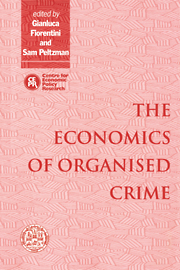Book contents
- Frontmatter
- Contents
- List of figures
- List of tables
- Foreword
- Acknowledgements
- List of conference participants
- 1 Introduction
- PART I THEORIES OF THE STATE AND THE ORIGIN OF CRIMINAL ORGANISATIONS
- PART II THE CRIMINAL ORGANISATION AS A FIRM
- PART III ORGANISED CRIME AND STATE INTERVENTION IN THE ECONOMY
- PART IV DETERRENCE POLICIES AGAINST LEGAL FIRMS INVOLVED IN ILLEGAL ACTIVITIES
- 8 Auditing with ‘ghosts’
- Discussion
- 9 The reputational penalty firms bear from committing criminal fraud
- Discussion
- PART V DETERRENCE POLICIES AGAINST ORGANISED CRIME
- Index
8 - Auditing with ‘ghosts’
Published online by Cambridge University Press: 04 August 2010
- Frontmatter
- Contents
- List of figures
- List of tables
- Foreword
- Acknowledgements
- List of conference participants
- 1 Introduction
- PART I THEORIES OF THE STATE AND THE ORIGIN OF CRIMINAL ORGANISATIONS
- PART II THE CRIMINAL ORGANISATION AS A FIRM
- PART III ORGANISED CRIME AND STATE INTERVENTION IN THE ECONOMY
- PART IV DETERRENCE POLICIES AGAINST LEGAL FIRMS INVOLVED IN ILLEGAL ACTIVITIES
- 8 Auditing with ‘ghosts’
- Discussion
- 9 The reputational penalty firms bear from committing criminal fraud
- Discussion
- PART V DETERRENCE POLICIES AGAINST ORGANISED CRIME
- Index
Summary
Introduction
This paper is about tax cheating by firms. Our aim is to compare the audit strategies available to a tax authority attempting to collect indirect taxes from sellers prone to evade. We model indirect tax evasion as follows: firms choose between taxable sales on the regular market and unreported sales in an informal market. The latter will typically be for cash. There are three options open to each firm: specialising in legal sales (honesty), selling on both markets (diversifying) or specialising in informal sales (submerging). We call firms that choose the third option ‘ghosts’. Section 2 of the paper outlines our model.
As in Allingham and Sandmo (1972), tax evasion is a gamble. If a firm is audited and found to be making irregular sales, it is fined and made to pay back the evaded tax. Which firms should the authority audit? One possible strategy is to audit randomly, with some fixed probability that any firm is investigated. An alternative enforcement policy is to tailor the audit strategy to take into account what the authority knows about each firm. A simple form of this approach is where the authority conditions audit probability solely on reported turnover via a cut-off rule: those reporting less (no less) than a certain amount are always (never) audited. In Section 5 we compare this cut-off policy with random audit and investigate which is likely to yield the authority more revenue.
The authority may also have access to information which is likely to be correlated with a firm's turnover. Such information will define its audit class in the sense used by Scotchmer (1987).
- Type
- Chapter
- Information
- The Economics of Organised Crime , pp. 185 - 196Publisher: Cambridge University PressPrint publication year: 1996
- 1
- Cited by



